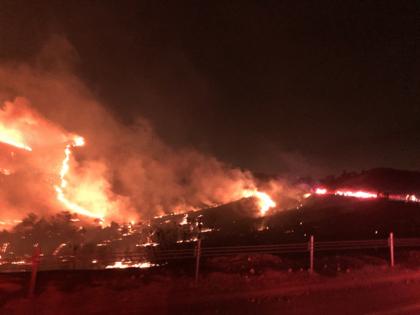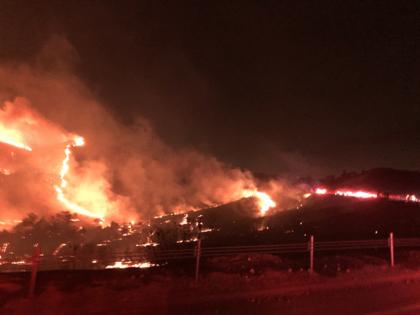'Above-normal fire potential': San Diego Gas & Electric prepares for peak wildfire season
Published in News & Features
SAN DIEGO — Buckle up for another potentially dangerous peak wildfire season in the San Diego area.
“We’ve only had about 50% of the normal rainfall, and temperatures are expected to be warm as we get into this summer,” Brian D’Agostino, meteorologist and vice president of wildfire and climate science at San Diego Gas & Electric, said Monday.
A combination of dry vegetation and hot weather increases the risk for brush fires and potential wildfires across the county in the coming months.
“We are expecting above-normal fire activity as we head through this summer,” D’Agostino said. “And I expect our above-normal fire potential to last into fall.”
D’Agostino heads a team of six meteorologists at SDG&E’s Wildfire and Climate Resilience Center at the utility’s headquarters in Kearny Mesa.
The weather network monitors more than 130 cameras that stream views of high-fire risk areas. The system includes 223 stations that measure wind speed, temperatures and humidity every 10 minutes. To bolster safety, the meteorology team integrates state-of-the art data from multiple sources, including the National Weather Service, with artificial intelligence.
“But it’s not just wildfire that we’re preparing for,” D’Agostino said. “All of these tools do help us be resilient to all types of weather-related hazards.”
And the weather has been freaky lately.
Southern Californians are long accustomed to blustery and potentially dangerous Santa Ana winds. But even the most experienced meteorologists were taken aback when Santa Anas blew through the region in January, instead of much later in the year.
The Los Angeles area suffered the worst effects of the combination of hurricane-force winds, low humidity and drought conditions that produced fires in places such as Pacific Palisades and Altadena.
A series of 14 wildfires ripped through region between Jan. 7 and Jan. 31, destroying more than 18,000 homes and structures.
San Diego was spared from the most destructive elements, but no less than six waves of Santa Ana winds — some surpassing 100 mph in places such as Sill Hill in the Cuyamaca Mountains — led SDG&E to issue two separate public safety power shutoffs over the course of an unprecedented three weeks.
The power shutoffs are deployed by investor-owned utilities in California to de-energize circuits in targeted areas when high winds and dry conditions elevate the risk of power lines falling and potentially igniting a wildfire. In San Diego County, they most commonly affect backcountry and rural communities such as Alpine, Julian, Fallbrook and Valley Center.
“In the 16 years I’ve been doing this, we’ve never had (a public safety power shutoff) event that went three weeks before January came,” D’Agostino said.
Given the long-range weather forecast, is there a higher chance of shutoffs this summer and fall in the San Diego area?
“I don’t know if I would say there’s an elevated risk,” D’Agostino said, noting that in 2022 and 2023 the region fortunately received moisture from a tropical storm. “I’ll say we are as ready as we have ever been to support the community in the case of a public safety power shutoff.”
Last week, in what local fire officials hope is not an omen for the coming months, crews on the ground in the air battled a pair of fires near Lakeside. The largest of the two prompted evacuations and burned more than 1,000 acres in a mostly remote area before being extinguished.
“We have to be prepared every year in San Diego,” D’Agostino said. “It’s almost like if you were in Florida and you’re asking, is the hurricane season worse this year than it was last year? All it takes is one hurricane to really impact the community and it’s the same thing here in San Diego. It just takes one fire.”
Since wildfires in 2007 ravaged large swaths of San Diego County, SDG&E has spent roughly $6 billion in ratepayers funds to reduce the risk of widespread fires.
That includes building the Wildfire and Climate Resilience Center, creating what’s considered a state-of-the-art network, placing 315.8 miles of power lines underground since 2020 and replacing wooden power poles with fire-resistant steel poles.
But that spending is a major contributor to the rates that San Diego customers pay on their bills each month, and SDG&E’s rates have consistently been either the highest or among the highest in the country.
“Building a safer, more resilient energy future requires preparing our electric grid before risks become realities,” D’Agostino said. “We have led the nation in prioritizing wildfire prevention through strategic and risk-informed undergrounding, fire-hardening infrastructure, and use of advanced technologies — helping us avoid a catastrophic utility-caused wildfire for 17 years.”
The two other large investor-owned utilities in California have experienced deadly wildfires on their watch in recent years.
Southern California Edison is being investigated over possible ignition of the Eaton Fire in Altadena. In 2017, the Thomas Fire in Edison’s service territory destroyed 1,063 structures and killed one resident and one firefighter.
Pacific Gas & Electric has been faulted for multiple fires in recent years, including the Zogg Fire in 2020 that killed four, the Dixie Fire in 2021 that cost $637.4 million to put out and the devastating Camp Fire in 2018 that killed 85.
_____
©2025 The San Diego Union-Tribune. Visit sandiegouniontribune.com. Distributed by Tribune Content Agency, LLC.










Comments